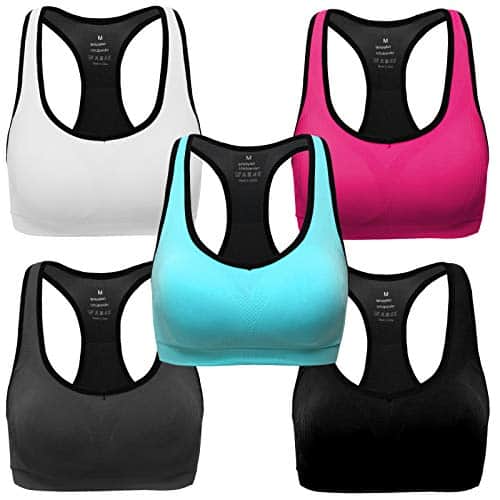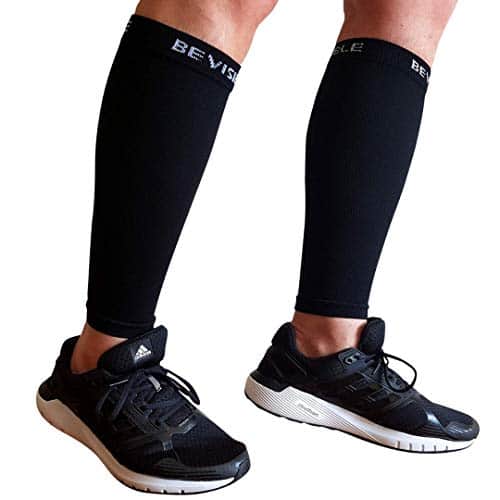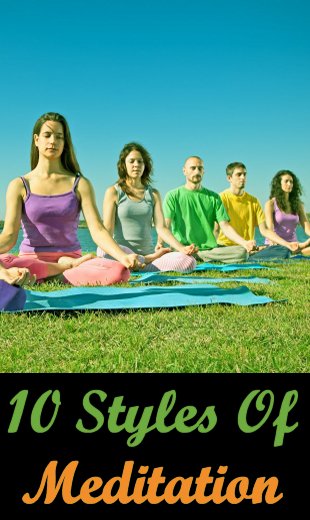What You Should And Shouldn’t Wear To Practise Yoga
So, you’ve read about the many benefits of yoga, and now you want to give it a try, but you’re not sure what to wear.
You’re probably thinking that something “loose and comfy” is fine, but it’s a bit more involved than that – and that’s what this article goes into.
Tops
If you wear a top that is loose, then you may find that, when you adopt certain poses, especially inverted ones (e.g. the Downward Facing Dog), you expose more of your body than you might want to, which is obviously a larger problem for women than it is for men.
Loose tops (e.g. ones that are on the baggy side) can also get in your way as you move around.
The thing is, comfortable and loose are not always synonymous – you can wear tops that are comfy but that are not overly loose.
And this should be your goal – a top that is fitted to your body and long, so it will keep you covered regardless. And for women, avoid low-cut tops too.
Another problem with wearing a top that is too loose is that your instructor, assuming you have one, will find it more difficult to determine whether your alignment is correct.
While you may think that cotton is your best bet, the problem with that is that it absorbs moisture and becomes heavier, so try to go for a top that is made from moisture-wicking material.
And in terms of colour, darker is better, because even though it may not look like it, yoga will get you sweating, and lighter clothes will show those sweat stains more easily.
And finally, there are several options to choose from here – t-shirts (if they’re fitted and not too loose), tank tops, or even a sports bra (see next section).
An option that is frequently recommended is a racerback top, such as the following, because the design helps keep the top in place:
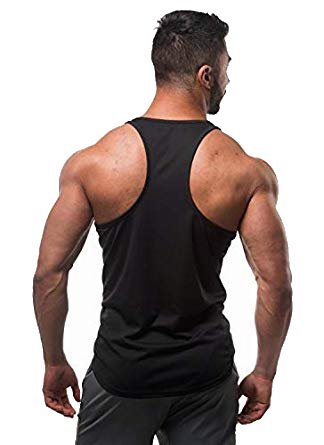 |
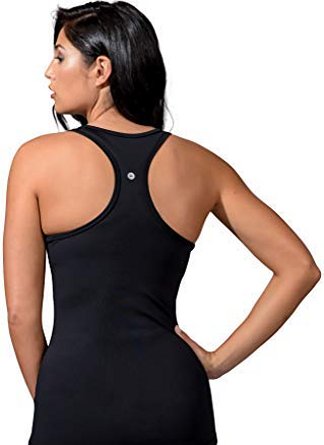 |
Bras
For women, you will definitely want to avoid anything that contains wires, because with all of the bending and stretching you’ll be doing, the last thing you need is something digging in to you.
The bra of choice for most yogis is a sports bra, which can be worn under another top, or in place of a top.
These have the advantage of covering more of your chest area (i.e. they are less revealing), and, as with tops (see above), you should try to make sure they are made from a moisture-wicking material with a racerback design:
Pants
There are three main reasons to avoid short, loose pants:
- For poses where one or more of your legs is supporting your arms, longer shorts will avoid “slippage”.
- They can bunch up, meaning you’ll be pulling them back down again every few minutes.
- For men, remember you don’t want to be exposing yourself!
For this reason, some yogis prefer to wear cycling shorts, which tend to be longer but still not too restrictive – and they’re great for absorbing moisture and for not chafing.
If you’d prefer to wear longer pants, then that’s OK too.
However, since you will typically be practising yoga barefoot, then you don’t want them so long that you end up tripping over them. This is why three-quarter length, Capri-style pants or leggings are popular.
They also need to be able to stretch, while still having a snug fit.
And speaking of that, they should have an elasticated waistband too, not only because they can stretch as you move about, but also because if they have a drawstring tie, you may find that becomes uncomfortable or even painful when you need to lie face down.
Remember too that whatever you choose, it should be made from a breathable, moisture-wicking fabric.
And lastly, from a modesty point of view, make sure that the pants you wear aren’t thinning, or even have holes, in unfortunate places such as the crotch area.
Underwear
As with all of the clothing you wear, your underwear should be made from a moisture-wicking material that is breathable, so while cotton may usually be comfortable, it’s not the best choice for yoga.
Briefs or even trunks are a great choice here – or, you can choose to go commando if you wish.
Footwear
As I mentioned above, yoga is usually practised barefoot, which means no shoes and no socks because they offer less grip on the mat, and you don’t want to be slipping around all over the place (because that can be dangerous).
So, wear whatever you want on your feet on the way to your yoga class, and then remove any shoes or socks when your lesson begins.
Compression Sleeves
These can be helpful if:
- You are prone to cramping or muscle pain.
- Your legs are cold.
As you can see, they typically cover from just below your knee down to your ankle, but leave your feet free (e.g. for gripping the yoga mat):
Headbands
Some people like to wear a headband to soak up any sweat, but this is, of course, entirely up to you.
If you find you are sweating a lot and it’s dripping into your eyes, then it’s probably worth wearing one, but otherwise, it adds nothing.
Additional Tips
Here are a few other considerations to bear in mind:
- It’s better to wear several thin layers, which you can peel off as necessary, than one thick layer.
- All sorts of people practise yoga, young and old, skinny and not so skinny, and they’re all there, like you, to learn and practise an activity that will benefit their health. So as long as you cover all of the areas that need to be covered, it really doesn’t matter what you wear – there’s no need to be self-conscious.
- The yoga studio is not a fashion runway, so you need to focus more on what’s comfortable and practical – designer logos won’t impress anybody.
- Avoid wearing jewellery, especially necklaces and pendants on long chains, as that can get in the way or get caught in your hair.
- While on the subject of wearables, you can retain your fitness monitor (although there are potential health concerns with many of these), provided that you ensure it won’t keep beeping and making other irritating noises during a group session.
- You can do yoga naked, if you want and you’re in an appropriate location (e.g. at home, not the yoga studio). 🙂
- Finally, if you are going to wear clothes, the key factors that make clothes suitable for yoga are comfort, fit, breathability, moisture-wicking capabilities, and modesty (because you don’t want to expose any more of your body than you would, say, at the beach).
Conclusion
Wearing the wrong clothing for any sporting activity can be distracting and uncomfortable, which takes your focus away from where it should be. (I remember being made to wear a different pair of shorts to the ones I liked when I was competing in the high jump finals at school sports day, and it completely threw me off my game.)
You may already have suitable clothing at home, but if not, you definitely do not need to spend a fortune on buying new items – a good top and/or a sports bra, and a pair of pants and you’re good to go.
Additional Resources
These are suggestions for those who wish to delve deeper into any of the above:
- Calf Compression Sleeve
- Find A Yoga Instructor (US only)
- Online Yoga Courses
- Sports Bra
- Yoga For Anxiety
- Yoga For Kids
- Yoga Mat
- Yoga Top (For Men)
- Yoga Top (For Women)

